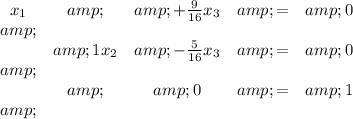Answer:
The system has no solution.
Explanation:
To find the solution to this system of linear equations

First, state the problem in matrix form, this means, extracting only the numbers, and putting them in a box.
![\left[ \begin{array}c -3 & 1 & -2 & 8 \\\\ 1 & 5 & -3 & 4 \\\\ -1 & 11 & -4 & 1 \end{array} \right]](https://img.qammunity.org/2021/formulas/mathematics/college/lcpvr4yr9lotxoi9x76dfxzmysguehsx3f.png)
This is called an augmented matrix. The word “augmented” refers to the vertical line, which we draw to remind ourselves where the equals sign belong
Next, transform the augmented matrix to the reduced row echelon form with the help of Row Operations.
Row Operation 1: multiply the 1st row by -1/3
![\left[ \begin{array}ccc 1 & - (1)/(3) & (2)/(3) & - (8)/(3) \\\\ 1 & 5 & -1 & 4 \\\\ -1 & 11 & -4 & 1 \end{array} \right]](https://img.qammunity.org/2021/formulas/mathematics/college/gbjq455g0le8xxmzdik4oct11zgv1lvuvj.png)
Row Operation 2: add -1 times the 1st row to the 2nd row
![\left[ \begin{array}ccc 1 & - (1)/(3) & (2)/(3) & - (8)/(3) \\\\ 0 & (16)/(3) & - (5)/(3) & (20)/(3) \\\\ -1 & 11 & -4 & 1 \end{array} \right]](https://img.qammunity.org/2021/formulas/mathematics/college/3sttqh5eopr3t1p8voy4i058zx4nib832m.png)
Row Operation 3: add 1 times the 1st row to the 3rd row
![\left[ \begin{array}ccc 1 & - (1)/(3) & (2)/(3) & - (8)/(3) \\\\ 0 & (16)/(3) & - (5)/(3) & (20)/(3) \\\\ 0 & (32)/(3) & - (10)/(3) & - (5)/(3) \end{array} \right]](https://img.qammunity.org/2021/formulas/mathematics/college/o7v7j8cswc4hwpdfcvqbdxvfm7510cetpb.png)
Row Operation 4: multiply the 2nd row by 3/16
![\left[ \begin{array}ccc 1 & - (1)/(3) & (2)/(3) & - (8)/(3) \\\\ 0 & 1 & - (5)/(16) & (5)/(4) \\\\ 0 & 0 & 0 & -15 \end{array} \right]](https://img.qammunity.org/2021/formulas/mathematics/college/j3xb3u2oo4c6mcoacyfxyvxdkmgqo03t1n.png)
Row Operation 5: add -32/3 times the 2nd row to the 3rd row
![\left[ \begin{array}c 1 &- (1)/(3) & (2)/(3) & - (8)/(3) \\\\ 0 & 1 & - (5)/(16) & (5)/(4) \\\\ 0 & 0 & 0 & -15 \end{array} \right]](https://img.qammunity.org/2021/formulas/mathematics/college/qic1p4j3wjln6jfw3dzh8jfepeu5e3ogkw.png)
Row Operation 6: multiply the 3rd row by -1/15
![\left[ \begin{array}c 1 &- (1)/(3) & (2)/(3) & - (8)/(3) \\\\ 0 & 1 & - (5)/(16) & (5)/(4) \\\\ 0 & 0 & 0 & 1 \end{array} \right]](https://img.qammunity.org/2021/formulas/mathematics/college/p6apd46spw9i0z6upci8z1lgarly822zmx.png)
Row Operation 7: add -5/4 times the 3rd row to the 2nd row
![\left[ \begin{array}ccc 1 &- (1)/(3) & (2)/(3) & - (8)/(3) \\\\ 0 & 1 & - (5)/(16) & 0 \\\\ 0 & 0 & 0 & 1 \end{array} \right]](https://img.qammunity.org/2021/formulas/mathematics/college/wujf5pvwrrczjbs8nz8s9xwwx5fysogsny.png)
Row Operation 8: add 8/3 times the 3rd row to the 1st row
![\left[ \begin{array}ccc 1 &- (1)/(3) & (2)/(3) & 0 \\\\ 0 & 1 & - (5)/(16) & 0 \\\\ 0 & 0 & 0 & 1 \end{array} \right]](https://img.qammunity.org/2021/formulas/mathematics/college/5tizdoxfcra5wnclrfboyfxsctpbmxblwk.png)
Row Operation 9: add 1/3 times the 2nd row to the 1st row
![\left[ \begin{array}{cccc} 1 & 0 & (9)/(16) & 0 \\\\ 0 & 1 & - (5)/(16) & 0 \\\\ 0 & 0 & 0 & 1 \end{array} \right]](https://img.qammunity.org/2021/formulas/mathematics/college/j73k7c76g1lz3z206h9ljt08kjeakicg2t.png)
The reduced row echelon form of the augmented matrix is
![\left[ \begin{array}{cccc} 1 & 0 & (9)/(16) & 0 \\\\ 0 & 1 & - (5)/(16) & 0 \\\\ 0 & 0 & 0 & 1 \end{array} \right]](https://img.qammunity.org/2021/formulas/mathematics/college/j73k7c76g1lz3z206h9ljt08kjeakicg2t.png)
which corresponds to the system

Equation 3 cannot be solved, therefore, the system has no solution.